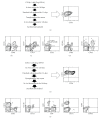Human hematopoietic stem cells can survive in vitro for several months
- PMID: 19960048
- PMCID: PMC2778179
- DOI: 10.1155/2009/936761
Human hematopoietic stem cells can survive in vitro for several months
Abstract
We previously reported that long-lasting in vitro hematopoiesis could be achieved using the cells differentiated from primate embryonic stem (ES) cells. Thus, we speculated that hematopoietic stem cells differentiated from ES cells could sustain long-lasting in vitro hematopoiesis. To test this hypothesis, we investigated whether human hematopoietic stem cells could similarly sustain long-lasting in vitro hematopoiesis in the same culture system. Although the results varied between experiments, presumably due to differences in the quality of each hematopoietic stem cell sample, long-lasting in vitro hematopoiesis was observed to last up to nine months. Furthermore, an in vivo analysis in which cultured cells were transplanted into immunodeficient mice indicated that even after several months of culture, hematopoietic stem cells were still present in the cultured cells. To the best of our knowledge, this is the first report to show that human hematopoietic stem cells can survive in vitro for several months.
Figures




Similar articles
-
Long-lasting in vitro hematopoiesis derived from primate embryonic stem cells.Exp Hematol. 2006 Jun;34(6):760-9. doi: 10.1016/j.exphem.2006.03.004. Exp Hematol. 2006. PMID: 16728281
-
Hematopoietic microchimerism in sheep after in utero transplantation of cultured cynomolgus embryonic stem cells.Transplantation. 2005 Jan 15;79(1):32-7. doi: 10.1097/01.tp.0000144058.87131.c5. Transplantation. 2005. PMID: 15714166
-
Enforced activation of STAT5A facilitates the generation of embryonic stem-derived hematopoietic stem cells that contribute to hematopoiesis in vivo.Stem Cells. 2004;22(7):1191-204. doi: 10.1634/stemcells.2004-0033. Stem Cells. 2004. PMID: 15579639
-
Nonhuman primate embryonic stem cells as a preclinical model for hematopoietic and vascular repair.Exp Hematol. 2005 Sep;33(9):980-6. doi: 10.1016/j.exphem.2005.06.008. Exp Hematol. 2005. PMID: 16140145 Review.
-
From embryos to embryoid bodies: generating blood from embryonic stem cells.Ann N Y Acad Sci. 2003 May;996:122-31. doi: 10.1111/j.1749-6632.2003.tb03240.x. Ann N Y Acad Sci. 2003. PMID: 12799290 Review.
Cited by
-
Identification of novel targets of CSL-dependent Notch signaling in hematopoiesis.PLoS One. 2011;6(5):e20022. doi: 10.1371/journal.pone.0020022. Epub 2011 May 26. PLoS One. 2011. PMID: 21637838 Free PMC article.
-
Industrially Compatible Transfusable iPSC-Derived RBCs: Progress, Challenges and Prospective Solutions.Int J Mol Sci. 2021 Sep 10;22(18):9808. doi: 10.3390/ijms22189808. Int J Mol Sci. 2021. PMID: 34575977 Free PMC article. Review.
-
In vitro erythropoiesis: the emerging potential of induced pluripotent stem cells (iPSCs).Blood Sci. 2024 Dec 26;7(1):e00215. doi: 10.1097/BS9.0000000000000215. eCollection 2025 Jan. Blood Sci. 2024. PMID: 39726795 Free PMC article. Review.
-
An Overview on Human Umbilical Cord Blood Stem Cell-Based Alternative In Vitro Models for Developmental Neurotoxicity Assessment.Mol Neurobiol. 2016 Jul;53(5):3216-3226. doi: 10.1007/s12035-015-9202-6. Epub 2015 Jun 4. Mol Neurobiol. 2016. PMID: 26041658 Review.
-
Cell Sources for Human In vitro Bone Models.Curr Osteoporos Rep. 2021 Feb;19(1):88-100. doi: 10.1007/s11914-020-00648-6. Epub 2021 Jan 15. Curr Osteoporos Rep. 2021. PMID: 33447910 Free PMC article. Review.
References
-
- Le Blanc K, Frassoni F, Ball L, et al. Mesenchymal stem cells for treatment of steroid-resistant, severe, acute graft-versus-host disease: a phase II study. The Lancet. 2008;371(9624):1579–1586. - PubMed
-
- Zon LI. Intrinsic and extrinsic control of haematopoietic stem-cell self-renewal. Nature. 2008;453(7193):306–313. - PubMed
-
- Heike T, Nakahata T. Ex vivo expansion of hematopoietic stem cells by cytokines. Biochimica et Biophysica Acta. 2002;1592(3):313–321. - PubMed
-
- Ando K, Yahata T, Sato T, et al. Direct evidence for ex vivo expansion of human hematopoietic stem cells. Blood. 2006;107(8):3371–3377. - PubMed
-
- Dexter TM, Allen TD, Lajtha LG. Conditions controlling the proliferation of haemopoietic stem cells in vitro. Journal of Cellular Physiology. 1977;91(3):335–344. - PubMed
LinkOut - more resources
Full Text Sources

